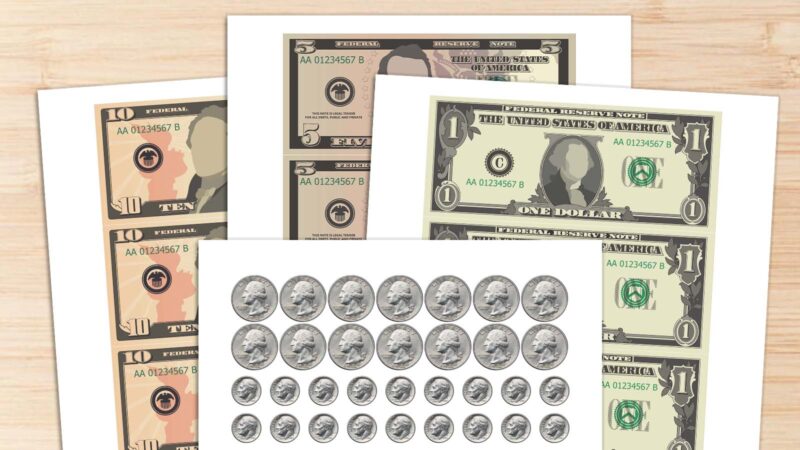Kids have a natural interest in money so that’s half the battle in learning about it! It’s also always a good idea when learning new math concepts to use a hands-on approach. With this Play Money Printable Bundle, you can get your class involved and learning in a very motivational, hands-on way.
First, fill out the form on this page to grab your free printable Play Money Bundle. Then check out the activities below.
The printables include all of the paper and coin money denominations, from $100 bills all the way down to pennies, which can be printed front-to-back to create realistic play currency.
Classroom Activity Ideas Using Printable Play Money
After you get your free money printables, try some of the games below with your students. Plus, check out even more of our money skills activities.
Coin ID Guessing Game
Introduce coins by passing out a set of the coin printables to each student. Discuss the characteristics of each one, such as name, color, size, who and/or what is depicted on the coin, and the value.
Then say, “We are going to play a guessing game. I will tell you three clues about a coin. When you think you know which coin it is, raise your hand.”
Have students take turns guessing all the coins in the set. Then have them take turns giving clues to the class with all printables put away. This game could also be played by guessing bills.
Skip-Count Practice
Coin counting has at its foundation skip-counts. Have each student take out their set of coins and bills. Ask them first to put out a row of 10 pennies. Count them aloud together by ones.
Then have students put out a row of 10 nickels. Skip-count these by fives. Then do the same thing with dimes, quarters, half-dollars, and dollars.
After this practice, give some mixed-count examples. For example, put out a row of five dimes followed by five nickels. Skip-count together by tens and then switch to fives. Try various combinations.
Invite students to pair up and create rows of combinations for each other to try. This is great practice for learning to count money!
Trading Game
This is a classic game, but kids still love it.
Put play coins and/or bills in the middle of a small group of four or five students. Players take turns rolling one die and taking that much money from the pile. For example, roll a 4, take 4 pennies; roll a 6, take 6 pennies or a nickel and a penny.
Once a player has enough to exchange or trade up to a larger-value coin, they should. For example, 5 pennies are traded for a nickel; 2 nickels for a dime. If a player has 7 pennies, they can trade 5 of them for a nickel, keeping the 2 other pennies.
The game can end at different points:
- Time goal: At the end of 15 minutes (or whenever the teacher calls time to end the game), kids count up their money. Whoever has the most money wins.
- Money goal: The first player to trade up to $1 (or another decided amount) is the winner.
How Much Is Here?
Give students a whiteboard or a sheet of paper. Display a coin or bill. Ask students to write the name of the denomination (e.g., penny, nickel, dollar bill, etc.) and the value. Check responses together.
Follow this by displaying three coins and/or bills (same or different). Students write the value of each, then add the values and write the total amount on the whiteboard or paper.
Can You Buy It?
From store flyers, online, magazines, or another source, copy and cut out pictures of some items kids are interested in, like food, snacks, toys, school supplies, etc. Write a money value on each one, from 5 cents to $4. Then hold up an item and ask students to use their play money to show the price of the item.
Match the Money Puzzles
Get a set of index cards. On one half of a card, tape or glue a coin or group of coins. On the other half (same side), write the value. Cut the card in half using different shapes of cutting lines, as with a puzzle. Make 10 or 12 of these. Students can help make them too.
Mix the card pieces up and give them to an individual student or a group of students. Have them work to put the puzzle pieces together to complete the puzzle. Then trade puzzle sets among groups.
Want your free Play Money Printable Bundle?

Just fill out the form on this page for immediate access!

